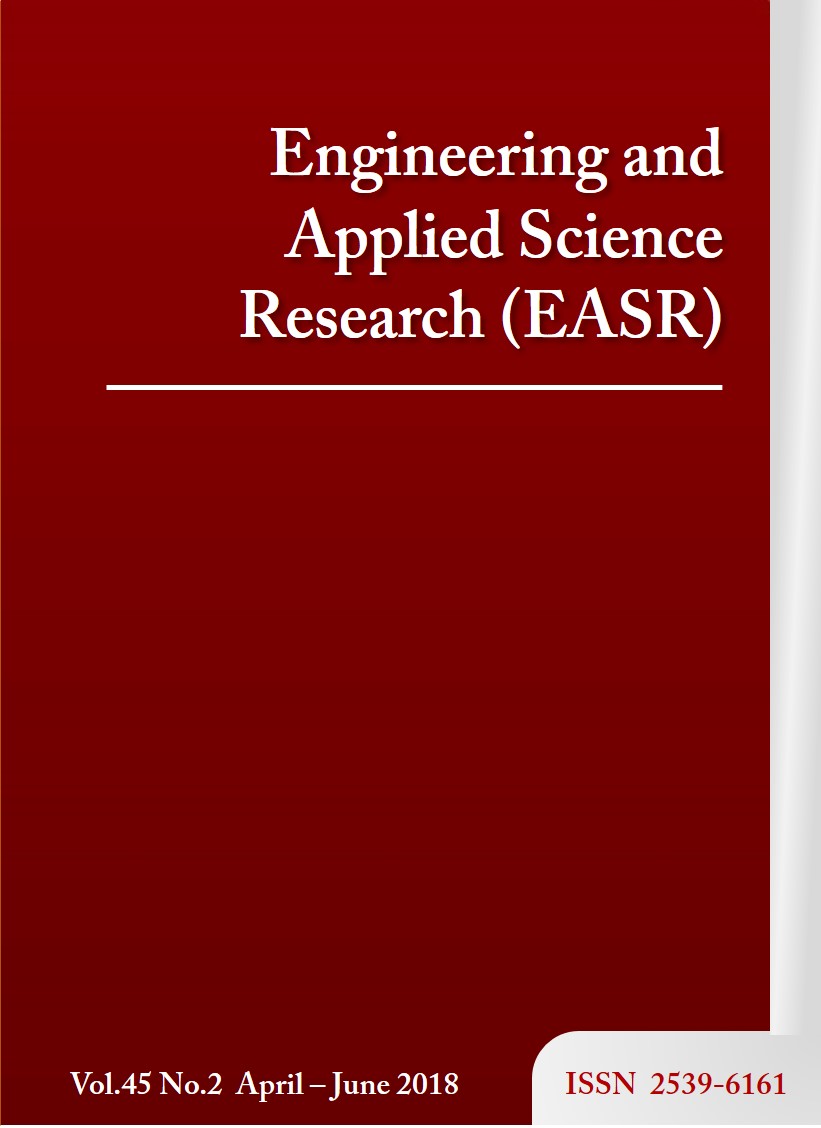Setting time, compressive strength and sulfuric acid resistance of a high calcium fly ash geopolymer containing borax
Main Article Content
Abstract
The objective of this research was to study the influence of borax on setting time and other properties viz., workability, compressive strength and sulfuric acid resistance of a high calcium fly ash (HCFA) geopolymer. Four borax types viz., deca‑hydrate borax, deca-hydrate borax heat‑treated for 5-minutes and 10-minutes and anhydrous borax were used to replace fly ash. A liquid to binder ratio (L/B) of 0.60, a 10M NaOH solution, and Na2SiO3/NaOH at a ratio of 1.0 were used in the formulation of the geopolymer. The results indicated that the replacement of fly ash with borax accelerated the initial setting time but retarded the final setting time of the geopolymer paste. The flow of mortar with deca-hydrate borax remained unaffected by the increase in the amount of borax. For other borax types, the mortar flow was reduced and this was related to the water molecules in the borax. The compressive strength of the mortar tended to decrease with increasing borax content. The resistance of the mortar to 3% sulfuric acid was reduced with increased borax content. The use of borax should be around 2.5% to control the setting of a high calcium fly ash geopolymer and to obtain good strength and resistance to acid.
Article Details
This work is licensed under a Creative Commons Attribution-NonCommercial-NoDerivatives 4.0 International License.
References
Rickard WDA, Temuujin J, van Riessen A. Thermal analysis of geopolymer pastes synthesised from five fly ashes of variable composition. Journal of Non-Crystalline Solids. 2012;358(15):1830-1839.
Silva PD, Sagoe-Crenstil K, Sirivivatnanon V. Kinetics of geopolymerization: Role of Al2O3 and SiO2. Cement and Concrete Research. 2007;37(4):512-518.
Chindaprasirt P, Chareerat T, Sirivivatnanon V. Workability and strength of coarse high calcium fly ash geopolymer. Cement and Concrete Composites. 2007;29(3):224-229.
Nematollahi B, Sanjayan J. Effect of different superplasticizers and activator combinations on workability and strength of fly ash based geopolymer. Materials and Design. 2014;57:667-672.
Pangdaeng S, Phoo-ngernkham T, Sata V, Chindaprasirt P. Influence of curing conditions on properties of high calcium fly ash geopolymer containing Portland cement as additive. Materials and Design. 2014;53:269-274.
Xie J, Kayali O. Effect of superplasticiser on workability enhancement of Class F and Class C fly ash-based geopolymers. Construction and Building Materials. 2016;122:36-42.
Chindaprasirt P, Chareerat T, Kunawanakit W. Geopolymer from Mae Moh fly ash. KKU Engineering Journal. 2005;32(5):715-724
Canfield GM, Eichler J, Griffith K, Hearn JD. The role of calcium in blended fly ash geopolymers. Journal of Materials Science. 2014;49(17):5922-33.
Winnefeld F, Leemann A, Lucuk M, Svoboda P, Neuroth M. Assessment of phase formation in alkali activated low and high calcium fly ashes in building materials. Construction and Building Materials. 2010;24(6):1086-93.
Temuujin J, van Riessen A, Williams R. Influence of calcium compounds on the mechanical properties of fly ash geopolymer pastes. Journal of hazardous materials. 2009;167(1-3):82-8.
Guo X, Shi H, Chen L, Dick WA. Alkali-activated complex binders from class C fly ash and Ca-containing admixtures. Journal of hazardous materials. 2010;173(1-3):480-486.
Rashad AM. A comprehensive overview about the influence of different admixtures and additives on the properties of alkali-activated fly ash. Materials and Design. 2014;53:1005-1025.
Zhang Z-h, Yao X, Zhu H-j, Hua S-d, Chen Y. Preparation and mechanical properties of polypropylene fiber reinforced calcined kaolin-fly ash based geopolymer. Journal of Central South University of Technology. 2009;16:49-52.
Songpiriyakij S, Pulngern T, Pungpremtrakul P, Jaturapitakkul C. Anchorage of steel bars in concrete by geopolymer paste. Materials and Design. 2011;32(5):3021-3028.
Phoo-ngernkham T, Chindaprasirt P, Sata V, Hanjitsuwan S. Influence of portland cement replacement in high calcium fly ash geopolymer paste. KKU Engineering Journal. 2014;41(1):19-27.
Phoo-ngernkham T, Chindaprasirt P, Sata V, Hanjitsuwan S, Hatanaka S. The effect of adding nano-SiO2 and nano-Al2O3 on properties of high calcium fly ash geopolymer cured at ambient temperature. Materials and Design. 2014;55:58-65.
Rattanasak U, Pankhet K, Chindaprasirt P. Effect of chemical admixtures on properties of high-calcium fly ash geopolymer. International Journal of Minerals, Metallurgy, and Materials. 2011;18(3):364-369.
Nath P, Sarker PK. Effect of GGBFS on setting, workability and early strength properties of fly ash geopolymer concrete cured in ambient condition. Construction and Building Materials. 2014;66:163-171.
Tennakoon C, Nicolas RS, Sanjayan JG, Shayan A. Thermal effects of activators on the setting time and rate of workability loss of geopolymers. Ceramics International. 2016.
Lee NK, Lee HK. Setting and mechanical properties of alkali-activated fly ash/slag concrete manufactured at room temperature. Construction and Building Materials. 2013;47:1201-1209.
Diaz EI, Allouche EN, Eklund S. Factors affecting the suitability of fly ash as source material for geopolymers. Fuel. 2010;89(5):992-996.
Nicholson CL, Fletcher RA, inventors. Geopolymers and methods for their production. New Zealand patent WO 2005/019130 A1. 2005.
Provis JL, van Deventer JSJ. Geopolymers Structure, processing, properties and industrial applications: Wood head publishing limited and CRC Press LLC; 2009. 454 p.
Williams RP, van Riessen A. Development of alkali activated borosilicate inorganic polymers (AABSIP). Journal of the European Ceramic Society. 2011;31(8):1513-1516.
Nazari A, Maghsoudpour A, Sanjayan JG. Characteristics of boroaluminosilicate geopolymers. Construction and Building Materials. 2014;70:262-268.
Kocakusak S, Koeroglu JH, Ekinci E, Tolun R. Production of Anhydrous Borax Using Microwave Heating. Industrial & Engineering Chemistry Research. 1995;34(3):881-5.
American Society for Testing and Materials (ASTM) C191. Standard Test Methods for Time of Setting of Hydraulic Cement by Vicat Needle;2013.
American Society for Testing and Materials (ASTM) C1437. Standard Test Method for Flow of Hydraulic Cement Mortar; 2013.
American Society for Testing and Materials (ASTM) C109/109M. Standard Test Method for Compressive Strength of Hydraulic Cement Mortars (Using 2-in. or [50-mm] Cube Specimens); 2013.
American Society for Testing and Materials (ASTM) C267. Standard Test Methods for Chemical Resistance of Mortars, Grouts, and Monolithic Surfacings and Polymer Concretes; 2012.
Chindaprasirt P, De Silva P, Sagoe-Crentsil K, Hanjitsuwan S. Effect of SiO2 and Al2O3 on the setting and hardening of high calcium fly ash-based geopolymer systems. Journal of Materials Science. 2012;47(12):4876-4883.
Sata V, Sathonsaowaphak A, Chindaprasirt P. Resistance of lignite bottom ash geopolymer mortar to sulfate and sulfuric acid attack. Cement and Concrete Composites. 2012;34(5):700-70




